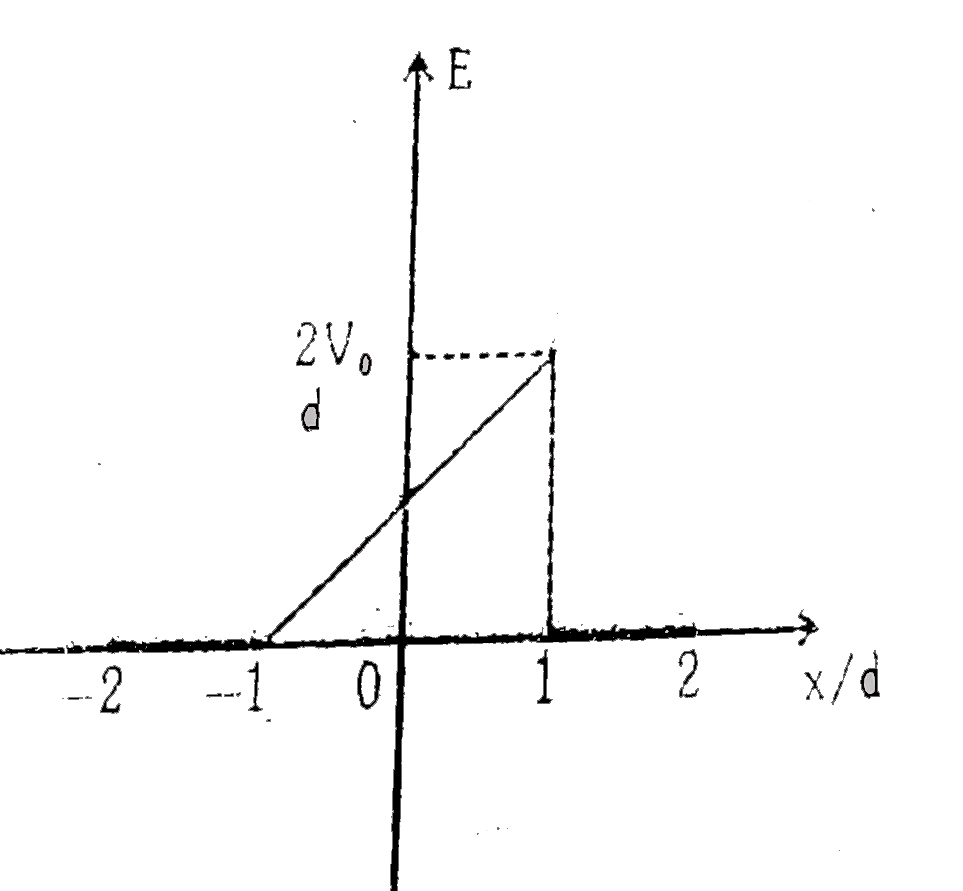The electric potential V(z,y,z) for a planar charge distribution is given by:
V(x,y,z)=⎧⎪
⎪
⎪
⎪
⎪
⎪
⎪⎨⎪
⎪
⎪
⎪
⎪
⎪
⎪⎩0for x<−d−V0(1+xd)2for −d≤x≤0−V0(1+2xd)for 0≤x<d−3V0for x>d
where −V0 is the potential at the origin and d is a distance. Graph of electric field as a function of position is given as Solution in Gujrati




The correct Answer is:A
E=−dvdx
Topper's Solved these Questions
- MISCELLANEOUSBOOK - ALLEN CHAPTER - MISCELLANEOUSEXERCISE - Exersice-03
7 Videos
- MISCELLANEOUSBOOK - ALLEN CHAPTER - MISCELLANEOUSEXERCISE - ASSERTION-REASON
18 Videos
- MISCELLANEOUSBOOK - ALLEN CHAPTER - MISCELLANEOUSEXERCISE - Part -II Example Some worked out Examples
1 Videos
- KINEMATICS (MOTION ALONG A STRAIGHT LINE AND MOTION IN A PLANE)BOOK - ALLEN CHAPTER - KINEMATICS (MOTION ALONG A STRAIGHT LINE AND MOTION IN A PLANE)EXERCISE - BEGINNER S BOX-7
8 Videos
- PHYSICAL WORLD, UNITS AND DIMENSIONS & ERRORS IN MEASUREMENT BOOK - ALLEN CHAPTER - PHYSICAL WORLD, UNITS AND DIMENSIONS & ERRORS IN MEASUREMENT EXERCISE - EXERCISE-IV
7 Videos
Similar Questions
Column IColumn II(A)1fermi(p)10−13m(B)1X-ray unit(q)10−15m(C)1angstrom(r)10−10m(D)1Astronomical unit(s)9.46×1015m(E)1Light year(t)3.26Light year(F)1Parse(u)3.08×1016m(v)1.49×1011m
View SolutionStatement 1: whenevever the unit of measurement of a quantity is changed, its numerical value changes.
and
Statement -2 : Smaller the unit of measurement smaller is its numerical value.
View SolutionFor spherically symmetrical charge distribution, electric field at a distance r from the centre of sphere is →E=kr7→r, where k is a constant. What will be the volume charge density at a distance r from the centre of sphere?
View SolutionA football player kicks a ball at an angle of 30∘ with an initial speed of 20 m/s. Assuming that the ball travels in a vertical plane, calculate (a) the time at which the ball reaches the highest point (b) the maximum height reached (c) the horizontal range of the ball (d) the time for which the ball is in the air, (g=10m/s2)
View SolutionAssertion : Gravitational forces do not depend on the medium between the masses.
Reason : Mediating particle responsible for gravitational force is graviton.
View Solutionfor every point (x,y,z) on the y-axis: (A) x=0,y=0 (B) x=0,z=0 (C) y=0,z=0 (D) y≠0,x=0,z=0
View SolutionCalculate the capacitance of a parallel plate capacitor, with plate area A and distance between the plates d, when filled with a dielectric whose permittivity varies as
∈(x)=∈0+kx(0<x<d2),∈(x)=∈0+k(d−x)(d2<x≤d).
View SolutionThe electric potential V(z, y,z) for a planar charge distribution is given by: V(x, y, z)={(0,,"for "x lt -d),(-V_(0)(1+x/d)^(2),,"for "-d le x le 0),(-V_(0)(1+2x/d),,"for "0 le x lt d),(-3V_(0),,"for " x gt d):} where -V_(0) is the potential at the origin and d is a distance. Graph of electric field as a function of position is given as
View Solutionf(x)⎧⎪⎨⎪⎩2x,ifx<00,if0≤x≤14x,ifx>1
View SolutionThe equation sinx+siny+sinz=−3 for 0≤x≤2π,0<y≤2π,0≤z≤2π has-
View SolutionMaximize :
Z=x+y,subject to the constraints:
x−y≤−1,−x+y≤0,x≥0,y≥0
View SolutionLet R be set of points inside a rectangle of sides a and b (a,b>1) with two sides along the positive direction of x-axis and y-axis(a) R={(x,y):0≤x≤a,0≤y≤b}(b) R={(x,y):0≤x<a,0≤y≤b}(c) R={(x,y):0≤x≤a,0<y<b}(d) R={(x,y):0<x<a,0<y<b}
View SolutionFor every point (x ,y, z) on the x- axis (except the origin) a. x=0, y=0, z≠0 b. x=0, z=0, y≠0 c. y=0, z=0, x≠0 d. x=y=z=0
View Solutionf(x)=⎧⎪⎨⎪⎩2x,ifx<00,if0≤x≤14x,ifx>1
View SolutionDifferentiate w.r.t x the function sin−1(x√x), where 0≤x≤1
View SolutionDifferentiate w.r.t x the function sin−1(x√x), where 0≤x≤1
View Solution
